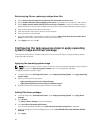
5
Command line options
DSDP supports the command line options supported in Dell Deployment Toolkit.
For more information on the command line options, usage guidelines, and syntax, see Dell OpenManage
Deployment Toolkit Version 4.4 Command Line Interface Reference Guide.
The SYSCFG and RAIDCFG commands are supported in DSDP
• SYSCFG — The Deployment Toolkit (DTK) system configuration utility SYSCFG commands enable you
to run commands to get information on configuration file format, and individual executables used to
configure server BIOS, DTK state settings, and system information including PCI device detection.
• RAIDCFG — The Deployment Toolkit (DTK) RAID configuration utility RAIDCFG provides commands to
configure all supported RAID controllers.
When using the SYSCFG commands, do the following changes to the commands, for example:
NOTE: To get correct results, it is recommended that you type command line options in the Task
Sequence wizard.
—acpower
Option
--acpower
Valid Arguments on, off, last
Description Sets the behavior for the system after AC power is lost. This option
specifies how the system responds to the restoration of AC power
and is particularly useful in systems that are turned off using a power
strip. When set to on, the system turns on after AC is restored. When
set to
off, the system does not turn on after AC is restored. When set
to last, the system turns on if the system was on when AC power was
lost. If the system was off when AC power was lost, the system
remains off when power is restored. This option can be replicated.
Example:
A:>syscfg --acpower=on acpower=on
Applicable Systems All Dell PowerEdge systems prior to PowerEdge 12G systems.
When using this command in DSDP, remove syscfg and run the command
--acpower=on acpower=on
When using the RAIDCFG commands, do the following changes to the commands, for example:
The following table lists the RAIDCFG options, parameters, and pre-defined arguments for setting the
name of a virtual disk on a controller.
34


















